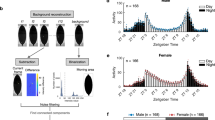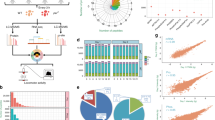Abstract
The genetic, molecular and anatomical dissection of the circadian clock in Drosophila and other higher organisms relies on the quantification of rhythmic phenotypes. Here, we introduce the methods currently in use in our laboratories for the analysis of fly locomotor activity rhythms. This phenotype provides a relatively simple, automated, efficient, reliable and robust output for the circadian clock. Thus it is not surprising that it is the preferred readout for measuring rhythmicity under a variety of conditions for most fly clock laboratories. The procedure requires at least 10 days of data collection and several days for analysis. In this protocol we advise on fly maintenance and on experimental design when studying the genetics of behavioral traits. We describe the setup for studying locomotor activity rhythms in the fruit fly and we introduce the statistical methods in use in our laboratories for the analysis of periodic data.
This is a preview of subscription content, access via your institution
Access options
Subscribe to this journal
Receive 12 print issues and online access
$259.00 per year
only $21.58 per issue
Buy this article
- Purchase on Springer Link
- Instant access to full article PDF
Prices may be subject to local taxes which are calculated during checkout









Similar content being viewed by others
References
Konopka, R.J. & Benzer, S. Clock mutants of Drosophila melanogaster. Proc. Natl. Acad. Sci. USA. 68, 2112–2116 (1971).
Cirelli, C. et al. Reduced sleep in Drosophila Shaker mutants. Nature 434, 1087–1092 (2005).
Cooper, K.W. Normal spermatogenesis in Drosophila. In Biology of Drosophila (ed. Demerec, M.) 1–61 (Wiley, New York, 1950).
Brand, A.H. & Perrimon, N. Targeted gene expression as a means of altering cell fates and generating dominant phenotypes. Development 118, 401–415 (1993).
McGuire, S.E., Roman, G. & Davis, R.L. Gene expression systems in Drosophila: a synthesis of time and space. Trends Genet. 20, 384–391 (2004).
Piccin, A. et al. Efficient and heritable functional knock-out of an adult phenotype in Drosophila using a GAL4-driven hairpin RNA incorporating a heterologous spacer. Nucleic Acids Res. [online] 29, e55 (2001)(doi:10.1093/nar/29.12.e55).
Hamblen, M.J., White, N.E., Emery, P.T., Kaiser, K. & Hall, J.C. Molecular and behavioral analysis of four period mutants in Drosophila melanogaster encompassing extreme short, novel long, and unorthodox arrhythmic types. Genetics 149, 165–178 (1998).
Helfrich-Forster, C. Differential control of morning and evening components in the activity rhythm of Drosophila melanogaster—sex-specific differences suggest a different quality of activity. J. Biol. Rhythms 15, 135–154 (2000).
Grotewiel, M.S., Martin, I., Bhandari, P. & Cook-Wiens, E. Functional senescence in Drosophila melanogaster. Ageing Res. Rev. 4, 372–397 (2005).
Mair, W., Goymer, P., Pletcher, S.D. & Partridge, L. Demography of dietary restriction and death in Drosophila. Science 301, 1731–1733 (2003).
Cirelli, C. Searching for sleep mutants of Drosophila melanogaster. Bioessays 25, 940–949 (2003).
Stanewsky, R. et al. The cryb mutation identifies cryptochrome as a circadian photoreceptor in Drosophila. Cell 95, 681–692 (1998).
Emery, P., So, W.V., Kaneko, M., Hall, J.C. & Rosbash, M. CRY, a Drosophila clock and light-regulated cryptochrome, is a major contributor to circadian rhythm resetting and photosensitivity. Cell 95, 669–679 (1998).
Rosato, E. et al. Light-dependent interaction between Drosophila CRY and the clock protein PER mediated by the carboxy terminus of CRY. Curr. Biol. 11, 909–917 (2001).
Dissel, S. et al. A constitutively active cryptochrome in Drosophila melanogaster. Nat. Neurosci. 7, 834–840 (2004).
Rieger, D., Shafer, O.T., Tomioka, K. & Helfrich-Forster, C. Functional analysis of circadian pacemaker neurons in Drosophila melanogaster. J. Neurosci. 26, 2531–2543 (2006).
Kyriacou, C.P. & Hall, J.C. Spectral analysis of Drosophila courtship song rhythms. Anim. Behav. 37, 850–859 (1989).
Zordan, M.A., Benna, C. & Mazzotta, G. Monitoring and analyzing Drosophila circadian locomotor activity. In Circadian Rhythms Methods and Protocols (ed. Rosato, E.) Methods in Molecular Biology series (Humana, Totowa, New Jersey, USA, in press).
Klarsfeld, A., Leloup, J.C. & Rouyer, F. Circadian rhythms of locomotor activity in Drosophila. Behav Processes. 64, 161–175 (2003).
Dowse, H.B. Statistical analysis of biological rhythm data. In Circadian Rhythms Methods and Protocols (ed. Rosato, E.) Methods in Molecular Biology series (Humana, Totowa, New Jersey, in press).
Helfrich-Forster, C. Robust circadian rhythmicity of Drosophila melanogaster requires the presence of lateral neurons: a brain-behavioral study of disconnected mutants. J. Comp. Physiol. A 182, 435–453 (1998).
Ashburner, M. Drosophila: a laboratory handbook. Ch 38 1191–1226 (Cold Spring Harbor Laboratory Press, Cold Spring Harbor, New York, 1989).
Collins, B.H., Dissel, S., Gaten, E., Rosato, E. & Kyriacou, C.P. Disruption of Cryptochrome partially restores circadian rhythmicity to the arrhythmic period mutant of Drosophila. Proc. Natl. Acad. Sci. USA 102, 19021–19026 (2005).
Högbom, J. Aperture synthesis with a non-regular distribution of interferometer baselines. Astrophys. J. Suppl. Ser. 15, 417–426 (1974).
Roberts, D.H., Lehar, J. & Dreher, J.W. Time series with CLEAN. Deviation of a spectrum. J. Astron. 93, 968–989 (1987).
Crane, P.C. Applications of the DFT/CLEAN technique to solar time series. Sol. Phys. 203, 381–408 (2001).
Acknowledgements
We wish to thank M.A. Zordan for the implementation of the MAZ software. We also thank BBSRC, NERC, the Royal Society and the Wellcome Trust for funding work in our laboratories. C.P.K. acknowledges a Royal Society Wolfson Research Merit Award, and a grant from the 6th Framework Project EUCLOCK (No. 018741).
Author information
Authors and Affiliations
Corresponding author
Ethics declarations
Competing interests
The authors declare no competing financial interests.
Rights and permissions
About this article
Cite this article
Rosato, E., Kyriacou, C. Analysis of locomotor activity rhythms in Drosophila. Nat Protoc 1, 559–568 (2006). https://doi.org/10.1038/nprot.2006.79
Published:
Issue Date:
DOI: https://doi.org/10.1038/nprot.2006.79
This article is cited by
-
Effects of lithium on locomotor activity and circadian rhythm of honey bees
Scientific Reports (2023)
-
Drosophila mutants lacking the glial neurotransmitter-modifying enzyme Ebony exhibit low neurotransmitter levels and altered behavior
Scientific Reports (2023)
-
Effects of adenosine receptor overexpression and silencing in neurons and glial cells on lifespan, fitness, and sleep of Drosophila melanogaster
Experimental Brain Research (2023)
-
Effects of insemination and blood-feeding on locomotor activity of wild-derived females of the malaria mosquito Anopheles coluzzii
Parasites & Vectors (2021)
-
Investigating cytosolic 5′-nucleotidase II family genes as candidates for neuropsychiatric disorders in Drosophila (114/150 chr)
Translational Psychiatry (2021)
Comments
By submitting a comment you agree to abide by our Terms and Community Guidelines. If you find something abusive or that does not comply with our terms or guidelines please flag it as inappropriate.



